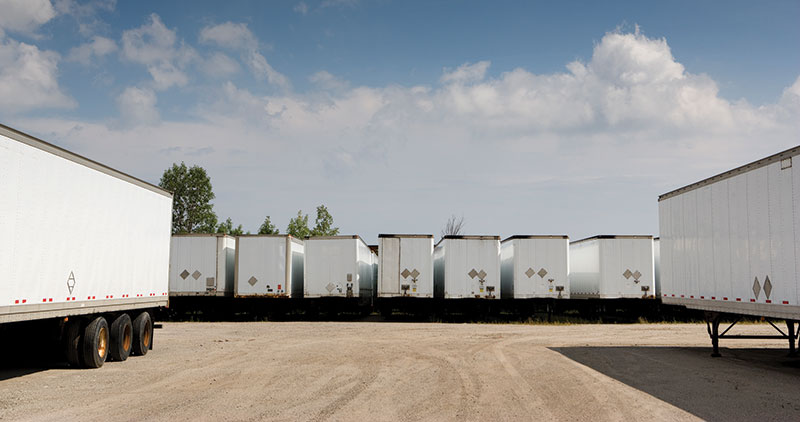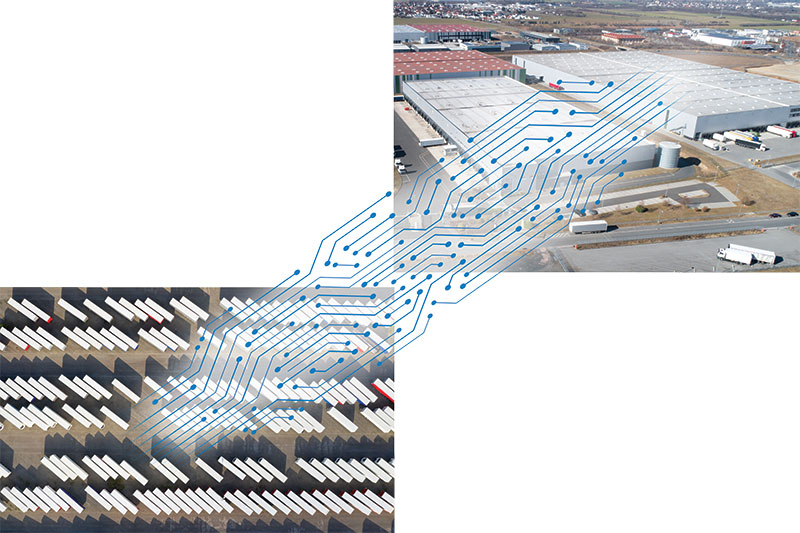Yard Management Systems (YMS): Bridging the gap between warehousing and transportation
Focused on improving visibility while also managing challenges like the labor shortage and supply chain disruptions, more shippers are turning to yard management systems (YMS) to optimize communication between their WMS and TMS applications—and seeing terrific overall service improvements in the process.
Activity that takes place within the four walls of the warehouse or DC is usually well orchestrated, documented, and in most cases, supported by technology. Using warehouse management systems (WMS), companies have been increasingly automating this aspect of their supply chains. Transportation management systems (TMS) take over once shipments reach the “other side of the gate,” so to speak, and make their way to their destinations.
And somewhere between the WMS and TMS lies the yard and dock, both of which have frequently been referred to as the “black holes” of the supply chain. That’s because at many facilities, these vital areas aren’t necessarily managed with technology, or the solutions in use don’t “talk” to other platforms.
This leaves gaps in the supply chain—something that companies have increasingly been trying to avoid in today’s fast-paced, resource-constrained fulfillment environment.
By using software that provides trailer and shipment visibility; automates the truck arrival, check-in and departure process; monitors trailer movement out in the yard; and tracks activity taking place on the dock, companies can bridge the gap between their existing solutions. They can also speed up their transportation operations, improve operator safety and reduce demurrage and detention charges.
Who’s using what
Yard management systems (YMS) help companies to achieve these goals and more, yet according to Peerless Research Group’s “2022 Materials Handling Technology Study,” their usage has been waning over the last few years.
While more than half (56%) of companies surveyed are using WMS and inventory management systems and 26% are using TMS, just 7% have deployed YMS in their operations. Looking back a bit further, the percentage of companies using YMS dropped from 17% in 2020 to 8% in 2021.
Despite what the numbers may say, Bill Brooks, vice president of Capgemini’s North American transportation portfolio, says that he’s seeing more interest in YMS on the part of shippers that want to get better visibility into their yard and dock activity.
Whether it’s due to the ongoing effects of the pandemic or the labor shortage (or both), he’s seeing more companies using self-service kiosks for trucks that are checking in and out of the yard. They’re also hooking their YMS systems into their existing WMS, TMS and enterprise resource planning (ERP) solutions with the goal of getting unified dashboards that everyone can rely on and work from.
“A bigger interest in YMS started about a year or two ago and has yet to wane,” says Brooks. “We’re continuing to see a lot of focus in that space, mainly because of the positive gains that can be captured by reducing inefficiencies and improving out in the yard.”
In response to this demand, he says WMS vendors are expanding their scope and adding YMS to their lineups while the best-of-breed yard management providers are adding new functionalities and capabilities.
“Software vendors are taking innovations from other supply chain management areas and applying them in the yard,” Brooks explains. These innovations include sensors, tracking mechanisms, data analytics and Edge computing, the latter of which speeds up the process of information retrieval by bringing computation and data storage closer to the data source. Armed with these insights, shippers can adjust on the fly faster, address problems quicker and make better decisions about their yard and dock activity.
The best-of-breed YMS vendors are also using more application programming interfaces (APIs) to connect their specialized yard management applications with the TMS, WMS, ERP and other solutions that the shippers already have in place. The Cloud is also supporting this movement and helping to “democratize” YMS and make it more available to a wider range of users.
Finally, Brooks says that he’s seeing more aerial drones being used in the yard, both for safety and security as well as for better tracking and visibility. “I think we’re going to see more of this, and particularly when it comes to yard monitoring that uses drones and Artificial Intelligence (AI)—and that will help to take the human error out of the equation.”
Key growth drivers
Simon Tunstall, research director, warehousing and fulfillment technologies at Gartner, is also seeing more demand for YMS right now. Some of the growth is being driven by rising fuel costs, ongoing labor constraints and the need for faster turnaround of visiting drivers. This is because extended dwell times not only result in higher carrier accessorial fees, but they also affect the drivers’ hours of service (HOS) compliance.
These and other realities are pushing more companies to explore YMS and all that it has to offer. In fact, Tunstall says he saw a significant surge in YMS-related inquiries during the peak COVID months—and that interest has yet to drop off. “Interest in YMS has continued, although not quite at the same rate that we saw during peak during the middle of the pandemic,” says Tunstall. “Still, it certainly hasn’t dropped off at all.”

Of particular interest right now are applications that support visiting drivers and that offer kiosks for them to use as they enter and exit the yard. Tunstall points to consulting firm MacGregor Partners and software provider Vector as two organizations that are focusing more on kiosks right now. By tying the kiosk and gate automation together, and by offering mobile devices that visiting drivers can use, these and other firms are helping companies streamline and automate their yards.
These solutions differ from more traditional YMS applications, which tend to focus on dock scheduling and the movement of containers and trailers out in the yard. Along with supporting visiting drivers, some of the newer solutions digitize paperwork and provide electronic bills of lading (eBLs) that help companies gain yard efficiencies.
Tunstall says that one of biggest selling points to YMS is the good return on investment (ROI) it provides in exchange for a comparatively small time and financial investment. “A YMS can provide quite a good ROI for a shipper that’s losing trailers, incurring detention costs and that wants to turn around visiting drivers faster,” he says. It can also help improve overall product flow both in and out of the warehouse or manufacturing operation, which in turn can even further enhance the software’s value for a specific shipper.
And, many YMS vendors offer fairly quick implementation times compared to other types of supply chain management applications, says Tunstall, and lower overall cost to run the software itself. Combined, these benefits make YMS attractive for many types of shippers, including very large, busy sites that currently rely on manual and disparate solutions to run their yard operations.
Know what you’re looking for
In some cases, current YMS users are assessing their existing systems and wondering how they can get even more out of them. This push to optimize existing YMS—and assumedly, most other types of SCM software right now—helps companies do more with what they have and avoids the expense of new software applications.
“I’ve definitely seen an uptick in interest from companies that already have YMS and are wondering whether they’re optimizing them or if there are opportunities to upgrade,” says Howard Turner, director, supply chain systems at St. Onge Company.
Shippers are also connecting existing software applications to gain better visibility, both in the yard and across the entire supply chain. For example, the firm that’s using a fleet tracking application to determine where trailers are on the road—and if they’re going to be delayed—may connect that software to a yard management system.
That way, the YMS has the information it needs to be able to track accurate arrival times and make predictions based on delays that are taking place on the road. Once the trailer arrives and gets inside of the gate, the YMS continues to track it and let users know when it’s time to pull up to the dock, pull away from the dock, and so forth.
“A bigger interest in YMS started about a year or two ago and has yet to wane…We’re continuing to see a lot of focus in that space, mainly because of the positive gains that can be captured by reducing inefficiencies and improving out in the yard.”
Turner sees this “digitization” of the yard as an important tool that companies can use to offset the labor challenges, supply chain constraints and other issues that affect the delivery times. With a YMS in place, companies can also eliminate issues like a driver waiting too long at the gate to be let in by a security guard or having to drive around and look for a spot in the yard. This, in turn, helps reduce dwell time—and the related carrier fees—while keeping drivers on the road and moving more efficiently.
To companies that want to start leveraging these and other benefits of YMS, Brooks says a good starting point is to know what you’re looking for. Identify your core yard- and dock-related challenges, and pinpoint the areas that are ripe for improvement. Look at both standalone and best-of-breed solutions and those being offered up as part of an existing WMS, TMS or ERP, and then decide which is the best fit for your specific needs.
“Keep your eyes open because there’s a lot of innovation taking place right now in terms of drones, AI, analytics and Edge computing—things that may not even be on your radar yet,” says Brooks. “In some cases, those innovations may be added with relatively little or no cost, and may give you some unexpected gains in return.”













